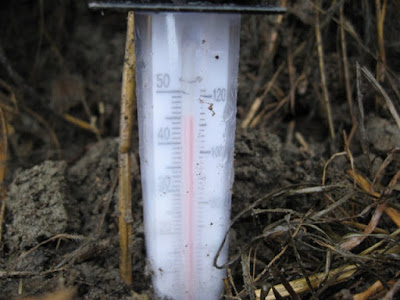Part science, part cooking class, composting is central to any organic farming operation - especially a farm like ours whose soils have no history of cultivation. Recent soil tests confirmed that we had only a modest organic content (2.5%) so composting would be the quickest way to supplement existing organic matter and support the young hop plants. After some quick calculations, we realized that we needed A LOT of compost to cover the 15 rows of the one acre hopyard. So, where to start? As it turns out, it's not that complicated. However, there are a number of factors that will influence the rate at which your raw material will break down. The most important consideration is obtaining an optimal Carbon:Nitrogen ratio. There are a number of compost calculators online to help you estimate this ratio using a suite of raw materials.
http://www.klickitatcounty.org/solidwaste/fileshtml/organics/compostcalc.htm
We opted for simplicity on our first attempt with alfalfa hay (carbon source) and horse manure (nitrogen source) as the sole ingredients. We sourced the hay from Texas Creek Ranch and have to thank Ekhard for graciously donating some old, broken down bails and the manure came from our neighbour who boards horses and had accumulated quite a bit over the winter.
Like making the world's largest lasagna, we spread thin layers of hay with scoops of manure, trying to water the layers along the way until we ran out of ingredients. Oh, I forgot to mention that Tim collected a dozen garbage bags of oak leaves he stole from a local Vancouver park near his house - he seemed to think the mold on the leaves would inoculate the pile to initiate the composting process. After covering the massive pile with tarps, we let microbiology take over.
After the first week, we discovered some surprises underneath the tarp...
Aside from being knee deep in animal excrement, my favourite part of the composting process is the stirring. For those of you who know me, this is also why I can't make rice but CAN make a mean stir fry.
Compost piles of such epic proportions, require mixing tongs of the hydraulic variety so when we were installing the poles, we took a moment to have Jason stir the stinking pile.
Of course, we recorded the temperature of the pile periodically over the 5 week period to ensure that weed seed would not germinate, kill pathogens, and to comply with the standards with certified organic protocols.
Temps after the first week. Looks like we need a thermometer a higher scale...temps regularly reached above 135 F in subsequent weeks.
Thursday, May 13, 2010
Wednesday, May 5, 2010
Trellis Triumphant




So much has happened in the last few months at the farm I don't know where to start! Spring has sprung forward like a jack-in-the-box and all of a sudden we find ourselves tending to second year hops planted under an almost-finished one-acre trellis! How did that happen!?
Let's take a few steps back:
We tried to install all the trellis poles last fall but an early winter caused us to rethink our schedule. So as soon as the ground thawed the first week of March, we were eager to complete the 88-pole trellis. We called up Jason and he was quick to return, this time with a Deere 50C excavator. Not too big not too small, this machine proved to be far more effective than a power auger. There's just no way an auger would be able to penetrate the aggregate rock we discovered at depths of about 3' and sometimes shallower.
Working quickly, we were able to sink one pole every 5-10 minutes. With the interior poles complete, we could now even out the lumps and bumps of the hop yard. Our budget solution was to drag a grader blade up, down, and across the rows from behind our F150. The blade was fixed to an old towing V and chained to the the truck hitch and we were off to the races in fine 'Chariots of Fire' style.
In my next post, I'll fill you in on all things compost...
Tim in the F150 discovering a wee dip in the terrain with Jason quick to the rescue!
Labels:
bc hops,
cedar poles,
hop trellis,
hop yard,
Lillooet,
organic hops
Subscribe to:
Comments (Atom)







